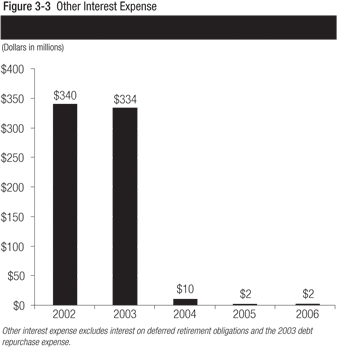| page 50 of 65 |
Chapter 3 Financial Highlights
time since the Postal Reorganization Act of 1970 that the Postal Service ended the year with no debt obligations outstanding.
In 2006, after funding the $2,958 million escrow required under P.L. 108–18, the Postal Service borrowed $2.1 billion to fund capital investments and provide operating cash for future operations. The September 30, 2006 borrowing provided the Postal Service with two thirds of the $3,230 million increase in cash from September 30, 2005 levels.
B. INTEREST EXPENSE
The Postal Service undertook debt refinancing actions in 2003, replacing all of the long-term debt obligations with shorter term debt, which laid the foundations for financial gains in 2004, 2005, and 2006. The Postal Service’s 2004 and 2005 debt consisted of short-term debt obligations, which provided it with the flexibility to repay debt with available cash on a daily basis. A major benefit of the short-term obligations was the reduction in interest expense payable to the Federal Financing Bank. As a result, the Postal Service was able to virtually eliminate interest on debt in 2004, 2005, and 2006, and reduce interest expense on borrowings to the lowest level since postal reorganization in the early 1970s.

C. INTEREST AND INVESTMENT INCOME
When the Postal Service determines that its funds exceed current needs, it invests those funds with the U.S. Treasury’s Bureau of Public Debt in overnight securities issued by the U.S. Treasury. With reduced or zero debt to repay, the Postal Service took advantage of a build up of cash and a rise in short-term interest rates to earn investment income of $140 million. This followed on the $60 million it earned in investment income in 2005.
The Postal Service also records imputed interest on the funds owed it under the Revenue Forgone Act of 1993. Under the Act, Congress is required to reimburse the Postal Service $29 million annually through 2035 for services it is directed to perform in the public interest. For more information, see Chapter 3, D. Federal Government Appropriations of this report.
D. LIQUIDITY
Postal Service liquidity is the cash in the Postal Service Fund in the U.S. Treasury; it is the amount of money the Postal Service can borrow on short notice, if needed. The Postal Service’s note purchase agreement with the Federal Financing Bank, renewed in 2006, provides for revolving credit lines of $4.0 billion. These credit lines enable the Postal Service to draw up to $3.4 billion with 2 days notice and up to $600 million on the same business day the funds are needed. Under this agreement, the Postal Service also, with 2 days notice, can draw upon a series of other notes with varying provisions. The notes provide the flexibility to borrow short-term or long-term, using fixed or floating rate debt, and can be either callable or noncallable. These arrangements with the Federal Financing Bank provide the Postal Service with adequate tools to effectively manage its interest expense and risk.
Certain statutory provisions limit the amount of funds the Postal Service can borrow. Total Postal Service debt outstanding cannot exceed $15 billion. In any fiscal year, the net increase in debt at year-end cannot exceed $3 billion, with no more than $2 billion of that limit being for capital purposes and $1 billion for operating expenses.
The Postal Service acted to increase its available cash to approximately $1 billion on September 30, 2006, up from $725 million at the end of 2005. The decision to increase its cash balance was made in consideration of an increasingly uncertain business environment. Uncertainties for 2007 include: the results of the Postal Service’s collective bargaining with its four major unions; the health of the overall economy; the outcome and impact of the first fully litigated rate case since R2000-1; an aggressive operating plan dependent on continued increases in productivity; further workhour reductions; and, the potential for the enactment of postal legislation with adverse cash flow consequences. Postal Service liquidity in 2007 will be comprised of the approximately $1 billion of cash that the organization has entering 2007, the cash flow that it can generate from operations; and, the $3.0 billion that it can borrow, if necessary. As was the case in 2006, in 2007, the Postal Service does not expect cash flow from operations to supply enough cash to fund both its escrow requirement and its capital investments. Consequently, the Postal Service anticipates increasing debt next year by at least $1.2 billion. However, this projection is not without risks and unfavorable events would cause a re-evaluation of the planned 2007 year-end levels of debt.